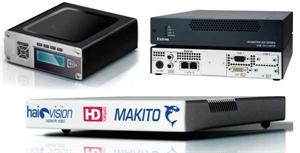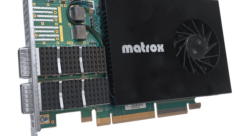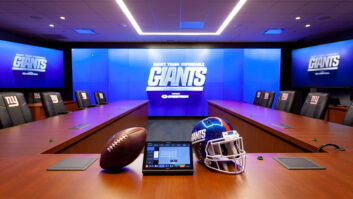

Sweet Streams: Video Hits the Network
If there’s an IT application than translates especially well into the AV world, it’s streaming media. These days, more pros are installing video codecs as part of videoconferencing and other systems.
A funny thing happened when the economy went in the tank: Business at Applied Visual Communications (AVC) picked upsignificantly. The Herndon, Va.–based integration firm exploited its expertise in videoconferencing installations to outfit organizations that had cut back on travel and wanted to use AV technology to stay productive.
Streaming appliances come in several varieties, from companies including (clockwise from top left) VBrick, Extron, and HaiVision.
Now something else is happening. AVC has begun to get more requests to incorporate streaming media into its designs.
“It is a growing requirement, but by no means is it the norm yet,” says AVC president Tom Peters. “I’d say it’s 10 percent at this point. But as the Millennials get more dominant in the workplace, the demand will increase dramatically.”
When Peters talks about streaming media, he doesn’t mean the videoconferencing systems themselves, though they, of course, represent a very specific, real-time version of the technology. He’s talking about technology that’s more IT than AV and well known to Web companies.
In general, streaming media comprises a video feed that is encoded on one end of a network so that it can travel across an Internet infrastructure, and then is decoded on another end for viewing. In a videoconference, this encoding and decoding is often done between two points (though multipoint conferences are increasingly possible) using codecs (so-called for their encoding and decoding functions).
But streaming media as it’s often referred to today, especially in IT circles, means different things in different applications, from broadcasting live video to hundreds of computer users, to storing video and offering it to viewers on demand over the Internet, a la YouTube. And it’s becoming an important tool in an AV integrator’s toolbox.
One reason AV firms such as AVC are seeing an increase in requests for streaming codecs is because clients are looking for a better return on investment from their new high-definition telepresence or videoconferencing rooms. Although costs for HD telepresence and videoconferencing have come down, they still represent a substantial investment. If an organization can do more with that system, solution providers say, it will be more willing to invest.
“Lots of channel partners who sell videoconferening systems sell streaming appliances,” says Andy Howard, senior director of marketing at VBrick Systems, which makes streaming codecs. “Sometimes they’ll just thrown one in. It’s a huge differentiator because it doesn’t add much cost to the room and it changes it from just a videoconferencing room into a broadcast studio.”
In fact, streaming codecs in traditional AV installations present such a significant opportunity that earlier this year, AV giant Extron Electronics purchased the products division of Electrosonic to get its hands on powerful streaming technology.
“Traditional AV equipment is well served if you’re just doing a room. But when you think of the needs of a national enterprise or the practical needs of a campus, streaming products play a foundational role,” says Karl Johnson, Extron Electronics director of product marketing. “There will be other situations when you bolt on video streaming codecs to an audiovisual system. It’s a specialty area and a growth area.”
Streaming Applications
In addition to extending the reach of videoconferences, organizations are using streaming codecs in other applications, often as a way of exploiting existing data networks and industry-standard TCP/IP to distribute video easily and economically.
Alpha Video & Audio installed NetStreams appliances at the Choctaw Casino in Oklahoma to send video to digital signage displays. Universities use streaming systems to capture lectures and either distribute them live or store them for on-demand viewing. Meanwhile, hospitals use streaming media codecs for telemedicine, and government and law enforcement agancies employ the technology for security monitoring and command and control. Some pro AV applications of various video streaming products include:
• The Children’s Hospital of Pittsburgh, which use the HaiVision Furnace video-over-IP system so that doctors can monitor the progress of surgeries live whether they are in the hospital, their offices, or at home.
• New York Law School, which installed 16 Sonic Foundry Mediasite Recorders to capture lectures and other events at the school and make them available online.
• The Walter E. Washington Convention Center in Washington, D.C., which uses VBrick H.264 codecs to stream content to more than 150 displays, including 60 high-definition panels.
• The U.S. Defense Department, which, along with its contractors, streams real-time content using Extron’s VN-Matrix systems to collaborate on mission-critical projects across multiple sites.
The type of AV-over-IP streaming technology that you will want to specify depends on the application that is best-suited to the task, the quality of video that application requires, and the level of interactivity that the client desires. By definition, a codec compresses and manipulates the native video for delivery over a network that may or may not already carry other data. (For more on digital video, see “Of Ones and Zeroes,” page 30.) For instance, multicasting a presentation to thousands of viewers over the Internet, regardless of whether they’re watching it on a computer, handheld device, or flat-panel display, may not require the highest-quality video encoding. Such applications require a codec that can stream the video in a standard, low-bit rate format, such as MPEG-2 or Windows Media. As streaming HD video becomes more prevalent, codecs that use the more efficient MPEG-4 compression standard and its H.264 variant are being used more widely.
There are other compression schemes in use. Extron’s VN-Matrix codecs, for instance, use something called Pure3, which is a proprietary format designed specifically for low-delay, low-latency, real-time streaming. Because it maintains high image quality with little or no delay, it’s the type of high-end codec that could be used in command and control, video production, and other interactive situations, particularly over a privately controlled network. Extron is also working on H.264-based codecs for more mainstream applications and even demonstrated a pre-production version at InfoComm 2010 in June. The company says that it will have standalone H.264 devices in the market in early 2011.
All-in-One Video Streaming
Streaming media won’t take over traditional AV distribution just yet, but it is becoming a more integrated part of AV system designs. Asked whether it might incorporate streaming codecs into existing products, Extron says H.264 “will be an integral part of its product offering.”
“You could see it as another input or output in a media presentation system,” says Extron’s Johnson. “When you think about it, these video codecs are just different signal formats. You have H.264, [Ethernet Audio Video Bridging], Pure3, and they all have attributes that can fit certain AV applications.”
For AVC’s Peters, half the fun is discovering new streaming products from which his customers can derive a real benefit. Recently he began evaluating a solution from 323link, which makes technology for capturing and distributing audio and/or video, plus presentation materials, which uses MPEG-4 or MP3 (for audio podcasts). What makes it different? Ease of use.
“You plug in a USB key and the system automatcally starts recording,” Peters explains. As streaming media becomes easier to deploy, expect to see it in even more pro AV installations.










